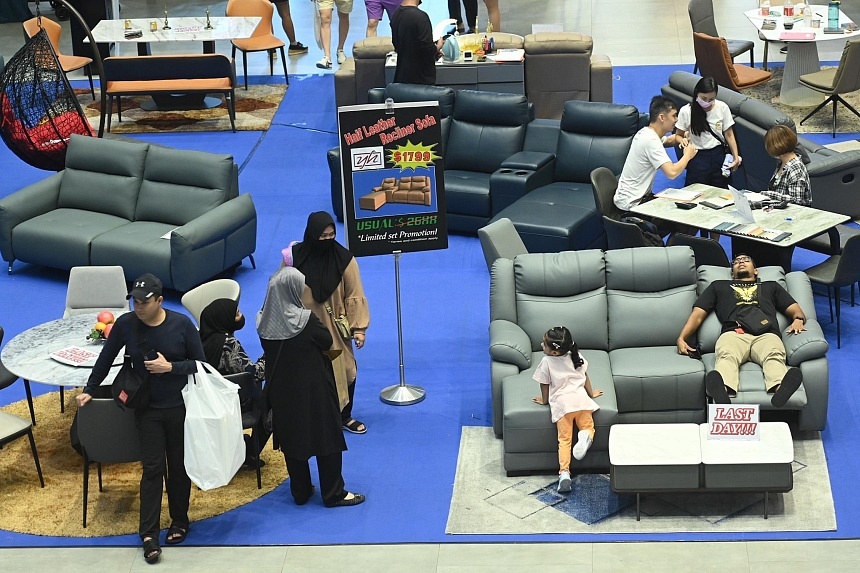SINGAPORE – Home is a refuge for most, but it can on rare occasions be the cause of illness.
Reports have surfaced recently of people in Singapore falling ill due to high formaldehyde levels in their furnishings.
Since 2020, the National Environment Agency (NEA) has received feedback on 19 cases involving formaldehyde levels arising from renovation works.
Formaldehyde is a water-soluble, colourless and pungent gas that gives off the “new house smell” at room temperature. It has multiple uses – as a disinfectant and fumigant, in furniture manufacturing, wood processing, textiles and leather.
Toxicity from formaldehyde can come from inhalation, skin exposure or ingestion.
While Singapore has guidelines for formaldehyde, they are not mandatory. A national safety standard applies for indoor air-conditioned spaces, where formaldehyde concentrations should be limited to 0.08 part per million (ppm).
In January 2023, Minister for Sustainability and the Environment Grace Fu said the Government would “very seriously” consider recommendations by industry leaders to set formaldehyde emission limits in building products and household furnishings.
Slightly over a year later, in March 2024, it was announced that Singapore will ban formaldehyde in paint used for the interiors of buildings from January 2026.
Other volatile organic compounds (VOCs) in the home that could make its inhabitants sick include asbestos and polybrominated diphenyl ethers (PBDEs), which are used as flame retardants.
The Straits Times asked Dr Jonathan Tang about the safe levels of VOCs within homes and what people can do if they think their health is being affected. He is a clinical toxicologist at both the Urgent Care Centre of Alexandra Hospital and the emergency medicine department of National University Hospital.
Q: What is the limit of formaldehyde before it becomes harmful to humans? Is the tolerance level lower for children and the elderly?
A: Different people differ in their sensitivity to odour and eye irritation. According to the US Environmental Protection Agency, an air concentration of 0.3 ppm of formaldehyde is safe for most people to avoid eye irritation.
In 2010, the World Health Organisation set an exposure limit of 0.1 ppm for formaldehyde.
This guideline was supported by studies from 2010 to 2013.
However, some people may have headaches or breathlessness even at such a low concentration.

Dr Tang said that as formaldehyde is heavier than air, higher concentrations are found closer to the ground. This makes children more prone to becoming ill.
“Children exposed to the same levels of formaldehyde as adults receive larger doses because they have a faster respiratory rate and a greater lung surface area (in proportion to their body weight) compared with adults,” he added.
On the other hand, elderly people are also vulnerable if they have pre-existing heart or lung conditions that make them less tolerant of the effects of formaldehyde, he said.
Q: How is long-term exposure to formaldehyde harmful to health and how do doctors treat formaldehyde-induced poisoning?
A: Chronic exposure to formaldehyde has been reported to cause obstructive lung disease and impaired lung function. It is also associated with nasopharyngeal cancer and leukaemia.
Most cases, however, involve mild irritation to the eyes, nose and throat and are resolved when the windows at the place in question are opened for two to three days, or when the person is no longer exposed to the formaldehyde.
Bronchodilators and steroids can be given when sufferers are exposed to higher concentrations that result in breathlessness which does not resolve.
In cases of skin exposure, clothing should be removed and the part of the skin affected washed with water.
If the formaldehyde has been ingested, the person should be taken immediately to the emergency department to be monitored.
Dr Tang added that a CT scan or endoscopy will also be performed to evaluate the extent of injury caused by the burning effect of the formaldehyde down the throat and to the stomach.
Q: Apart from furniture glue and paint, what other materials used in the renovation of a home can release toxins?
A: In the past, lead-based paint was used in homes, leading to reports of chronic lead exposure, but this is no longer a problem in Singapore. It banned the manufacture and import of paints containing lead in volumes exceeding 90 ppm from January 2022.
If your home was built between 1920 and 1978, you may be exposed to asbestos, which was commonly used as a building and insulation material at that time. Asbestos has been banned in Singapore since 1989 and is no longer used in construction materials.

“Acute inhalation of asbestos fibres causes local irritation at most. The main risk with asbestos lies with chronic repeated occupational exposure that manifests decades later with chronic lung disease and a significantly increased risk of lung cancer,” Dr Tang said.
In addition, the disposal of asbestos waste must be carried out only by NEA-approved contractors.
Not much is known about the effect of PBDEs on the human body. These are flame-retardant chemicals added to plastics and foam products found in a variety of consumer goods, from TVs and toasters to mattresses and drapes.
With increasing recognition of their potentially toxic effects, PBDEs were removed from consumer goods like mattresses and electronics in the US, Canada and Britain.
The use of PBDE as flame retardants in Singapore is not strictly regulated. These compounds can still be found in furniture, electronic devices and building materials.


